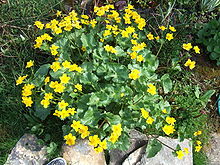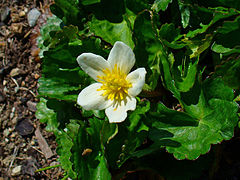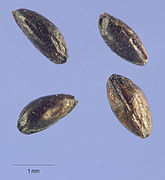Caltha palustris
| Caltha palustris | |
|---|---|

| |
| Scientific classification | |
| Kingdom: | Plantae |
| Clade: | Tracheophytes |
| Clade: | Angiosperms |
| Clade: | Eudicots |
| Order: | Ranunculales |
| Family: | Ranunculaceae |
| Genus: | Caltha |
| Species: | C. palustris
|
| Binomial name | |
| Caltha palustris | |
| Varieties | |
| Synonyms | |
|
Trollius paluster E.H.L.Krause
| |
Caltha palustris, known as marsh-marigold
Description
Caltha palustris is a 10–80 centimetres (4–31+1⁄2 in) high, hairless, fleshy, perennial, herbaceous plant that dies down in autumn and
Inflorescence
The common marsh-marigold mostly has several
Taxonomy
Taxonomic history
The oldest
Etymology

The generic name Caltha is derived from the Ancient Greek κάλαθος (kálathos), meaning "goblet", and is said to refer to the shape of the flower.[4] The species epithet palustris is Latin for "of the marsh" and indicates its common habitat.[5]
In the UK, Caltha palustris is known by a variety of vernacular names, varying by geographical region. These include in addition to the most common two, marsh marigold and kingcup, also brave bassinets, crazy Beth, horse blob,[
Subdivision, synonymy and culture varieties

Caltha palustris is a very
- Yellow sepals, pollen tricolpate, not rooting at the nodes.
→ C. palustris var. palustris =- C. palustris forma decumbens, f. erecta, f. gigas, f. plena, f. plurisepala, f. pratensis
- C. palustris subvar. palmata
- C. palustris var. acuteserrata, var. bosnica, var. crenata, var. cuneata, var. dentata, var. ficariaeformis, var. holubyi, var. minima, var. nipponica, var. orbicularis, var. ranunculiflora, var. recurvirostris, var. siberica (Regel, 1861), var. stagnalis, var. umbrosa
- C. palustris ssp. thracica
- C. alpestris, C. alpina, C. asarifolia, C. barthei, C. confinis, C. cornuta, C. elata, C. ficarioides, C. fistulosa, C. grosse-serrata, C. guerrangerii, C. himalensis, C. integerrima, C. intermedia, C. laeta, C. latifolia, C. longirostris, C. major, C. minor, C. orthorhyncha, C. pallidiflora, C. parnassifolia, C. polypetala, C. procumbens, C. pumila, C. pygmea, C. ranunculoides, C. riparia, C. silvestris, C. vulgaris
- Yellow sepals, pollen tricolpate, smaller plants, with few-flowered decumbent stems rooting at the nodes after flowering. Grows at the northern edges of the distribution area of the species and on erosion prone banks.
→ C. palustris var. radicans =- C. palustris var. aleutensis, var. siberica (Tolmachev, 1955)
- C. arctica, C. cespitosa, C. flabellifolia, C. zetlandica
- Yellow sepals, pollen De Biesbosch).
→ C. palustris var. araneosa (only generally recognised in the Netherlands) - White sepals, pollen pantoporate or sometimes tricolpate. Between 2200 and 3500 m along rivulets in Afghanistan, Pakistan and the western Himalayas from Kashmir to northern India.
→ C. palustris var. alba =- C. palustris forma alpina, f. sylvatica
- C. alba
- Magenta sepals, pollen tricolpate. Between 4000 and 5000 m in alpine meadows and mossy slopes between shrubs and tall herbs in the eastern Himalayas of Assam and southern Tibet.
→ C. palustris var. purpurea =- C. rubriflora
-
C. palustris var. alba
-
C. palustris var. purpurea
-
C. palustris var. palustris
-
opened follicles
-
seeds
The 2006–2007 edition of the Royal Horticultural Society Plant Finder, a British publication which lists over 70,000 plants available in nurseries in the United Kingdom, lists in addition to these varieties the following cultivars: Single flowered: "Marilyn", "Trotter's form", "Yellow Giant". Double flowered: "Flore Pleno" (RHS's Award of Garden Merit), "Multiplex", "Plena", "Semiplena".[7]
Distribution and habitat

The species is
Ecology
The marsh-marigold grows in places with oxygen-rich water near the surface of the soil. It likes richer soils, but dislikes application of
It is a component of
In western Europe, the marsh-marigold moth
Pollination

The flowers produce both nectar and copious amounts of pollen which attract many insect visitors. They may be most commonly pollinated by hoverflies (Syrphidae).
Caltha palustris is infertile when self-pollinated. Rather high fertility in crosses between sibling plants suggest that this phenomenon is genetically regulated by several genes. This regulation mechanism also occurs in Ranunculus and as far as known only in these two genera.[16]
Seed dispersal
In Caltha palustris up to two hundred seeds may be produced by each flower.[16] When the follicles open, they form a "splash cup". When a raindrop hits one at the right angle, the walls are shaped such that the seeds are expelled.[10] The seeds also have some spongy tissue that makes them float on water, until they wash up in a location that may be suitable for this species to grow.[17]
Diseases
The marsh-marigold is affected by the rust species Puccinia calthea and P. calthicola.[18]
Toxicity
Caltha contains several active substances of which the most important from a toxicological point of view is protoanemonin. Larger quantities of the plant may cause convulsions, burning of the throat, vomiting, bloody diarrhea, dizziness and fainting. Contact of the skin or mucous membranes with the juices can cause blistering or inflammation, and gastric illness if ingested. Younger parts seem to contain less toxics and heating breaks these substances down. Small amounts of Caltha in hay do not cause problems when fed to husbandry, but larger quantities lead to gastric illness.[19]
Additionally, plants that live in raw water may carry toxic organisms which can be neutralized by cooking.[9]
Uses
Early spring greens and buds of Caltha palustris are edible when cooked (but are poisonous when raw).[20] Young leaves or buds should be submerged a few times in fresh boiling water until barely tender, cut into bite-sized pieces, lightly salted, and served with melted butter and vinegar.[19] Very young flowerbuds have been prepared like capers and used as a spice.[10]
The common marsh marigold is planted as an ornamental throughout temperate regions in the world, and sometimes recommended for low maintenance wildlife gardens.[7] The double-flowered cultivar 'Flore Pleno' has won the Royal Horticultural Society's Award of Garden Merit.[21]
Culture
This section needs additional citations for verification. (May 2021) |
Caltha palustris is a plant commonly mentioned in literature, including
- Winking Marybuds begin
- To open their golden eyes (Cymbeline, ii. 3).
It also appears in Charlotte Brontë's Shirley:
- They both halted on the green brow of the Common: they looked down on the deep valley robed in May raiment; on varied meads, some pearled with daisies, and some golden with king-cups: to-day all this young verdure smiled clear in sunlight; transparent emerald and amber gleams played over it [22]
and in Thomas Hardy's poem 'Overlooking the River Stour':
- Closed were the kingcups; and the mead/Dripped in monotonous green,/Though the day's morning sheen/Had shown it golden and honeybee'd.
Kingcup Cottage by Racey Helps is a children's book which features the plant.
References
- ^ BSBI List 2007 (xls). Botanical Society of Britain and Ireland. Archived from the original (xls) on 2015-06-26. Retrieved 2014-10-17.
- ^ a b c Petra G. Smit (1973). "A Revision of Caltha (Ranunculaceae)". Blumea. 21: 119–150. Retrieved 2016-01-05.
- ^ Moss, C.E. (1920). The Cambridge British Flora. Vol. III. CUP Archive. pp. 104–105.
- ^ P.J. de Lange. "Caltha novae-zelandiae". New Zealand Plant Conservation Network. Retrieved 2016-01-11.
- ^ Archibald William Smith A Gardener's Handbook of Plant Names: Their Meanings and Origins, p. 258, at Google Books
- ^ "MOLLY-BLOB | Meaning & Definition for UK English | Lexico.com". Archived from the original on April 17, 2019.
- ^ a b c "RHS Plant Selector – Caltha palustris". Retrieved 20 June 2013.[permanent dead link]
- ^ "cowslip". Merriam-Webster Online Dictionary.
- ^ )
- ^ a b c d E.J. Weeda; R. Westra; C. Westra; T. Westra (1985). Nederlandse Oecologische Flora. Vol. 1. IVN. pp. 226–229.
- ^ Hilty, John (2020). "Marsh Marigold (Caltha palustris)". Illinois Wildflowers. Retrieved 2016-01-29.
- ISBN 978-9004090262.
- ^ Sue Trull. "Yellow Marsh Marigold". USDA – Plant of the week. Retrieved 2016-02-13.
- S2CID 83650928.
- ^ Hagerup, O. 1950. Rain-pollination. I kommission hos E. Munksgaard. Retrieved 26 May 2018.
- ^ .
- ^ "Marsh Marigold". NatureGate. Retrieved 2016-02-14.
- ^ Peter Zwetko: Die Rostpilze Österreichs. Supplement und Wirt-Parasit-Verzeichnis zur 2. Auflage des Catalogus Florae Austriae, III. Teil, Heft 1, Uredinales. (PDF; 1,8 MB).
- ^ a b "Caltha palustris". Native Plant Database. Lady Bird Johnson Wildflower Center, University of Texas at Austin. Retrieved 2016-01-17.
- OCLC 244766414.
- ^ "Caltha palustris 'Flore Pleno'". RHS. Retrieved 12 April 2020.
- ^ Brontë, Charlotte (8 July 2018). "Shirley, by Currer Bell" – via Google Books.
References
- Clapham, A. R., Tutin, T. G., and Warburg, E. F., 1962, Flora of the British Isles Cambridge University Press
- Lord, Tony (ed), 2006, RHS Plant Finder 2006–2007 London: RHS/Dorling Kindersley ISBN 1-4053-1455-9
- Mabey, Richard, 1997, Flora Britannica London: Chatto and Windus
- Rose, Francis, 2006, The Wild Flower Key (edition revised and expanded by Clare O'Reilly) London: Frederick Warne ISBN 0-7232-5175-4* Pink, A. (2004). Gardening for the Million. Project Gutenberg Literary Archive Foundation.
- Rines, George Edwin, ed. (1920). . Encyclopedia Americana.





